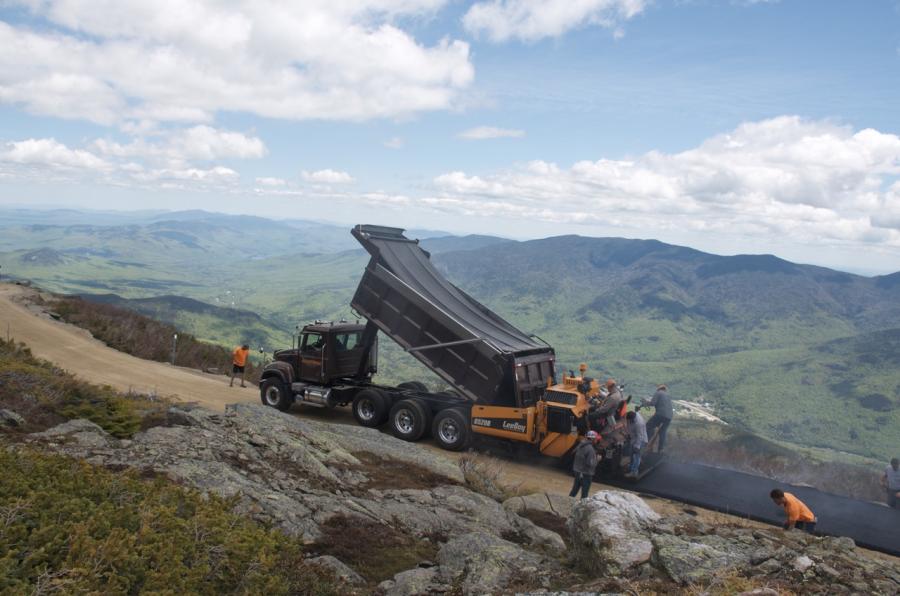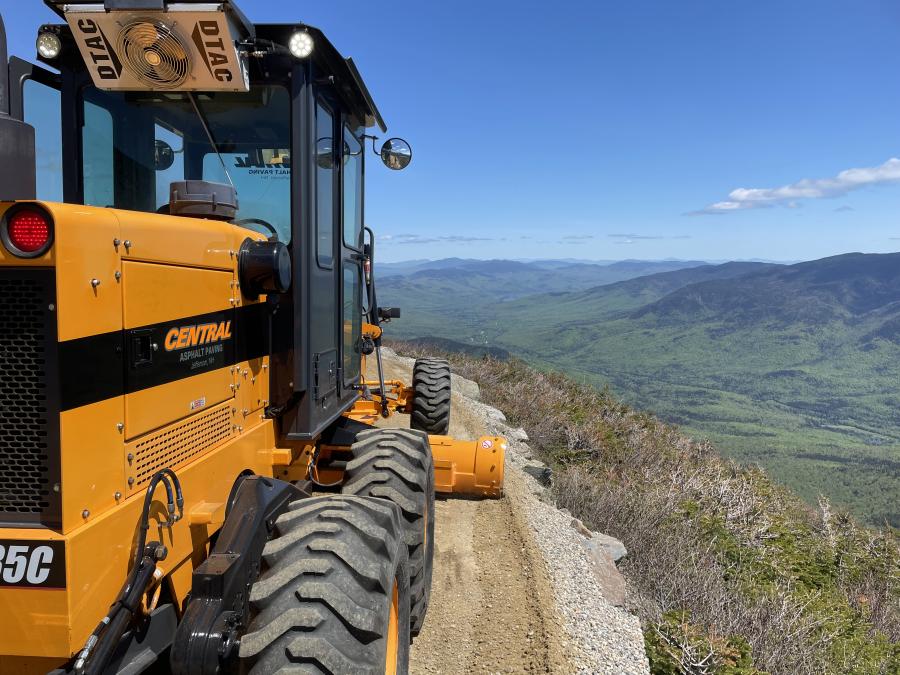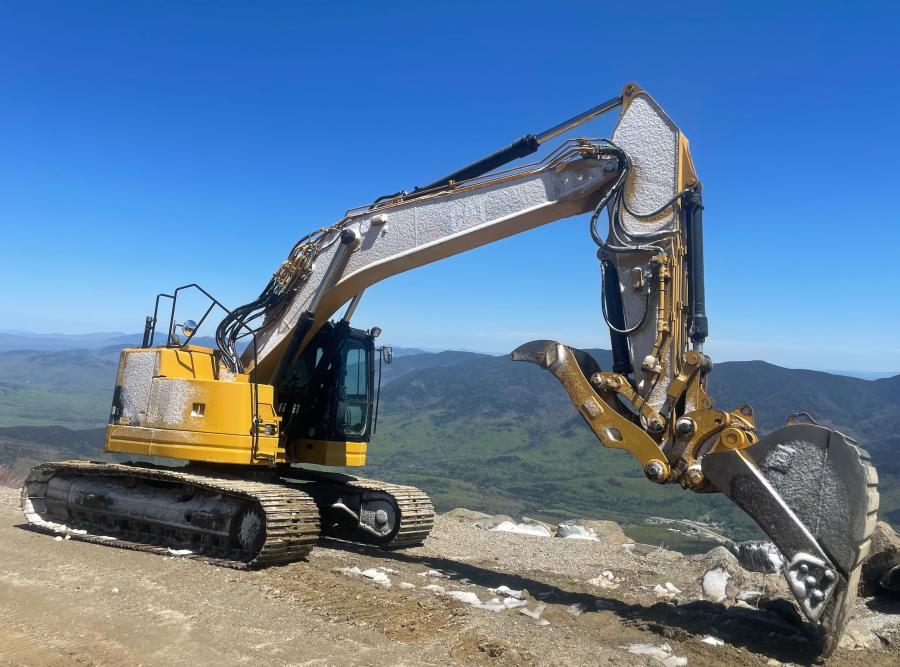The asphalt cooled within a few hours due to the cooler temperatures and was ready to take on traffic.
(Photo Courtesy of Mt. Washington Auto Road and Lee T. Corrigan LLC)
The last unpaved section of the 7.2-mi. Mount Washington Auto Road — two narrow dirt/gravel lanes, one in each direction for 6/10 of a mi. — which takes tourists, various officials and scientists to the summit of Mount Washington (6,288.2 ft.) in New Hampshire, was paved last spring.
This news of the paving was announced when the Mount Washington Auto Road, the private family-owned firm that owns and operates the road, tweeted: "Thank you to Central Paving crews out of Jefferson, N.H., and especially thanks to their drivers who had to drive the dumptrucks *backwards* up the 5-mile stretch to access this section of road. History in the making."
The road, which was established in 1861 at 6,288 ft. above sea level, is narrow and does not have a shoulder or guardrail. Rocks have been placed along the edge of the road to serve as a safety barrier, but there are a few areas where a misstep would plunge motorists down a sheer drop.
The mountain is the highest peak in the northeastern United States and is notorious for its erratic weather. On the afternoon of April 12, 1934, the Mount Washington Observatory recorded a windspeed of 231 miles per hour at the summit, the world record from 1934 until 1996. Mount Washington still holds the record for highest measured wind speed not associated with a tornado or tropical cyclone.
Engaging in roadwork on this peak is not easy.
The Auto Road is the oldest man-made and continuously operating tourist attraction in North America. It was built by hand using shovels and black powder to clear the route and has been owned for generations by the descendants of the Libby family.
"The paving of the section was a huge day for us and a turning point as our goal was always to get this road paved from top to bottom," said Tobey Reichert, general manager, Mt. Washington Auto Road, Gorham Land Company.
"A fully paved road will give a much better experience for all of our guests and it's definitely less maintenance for us. Maintaining a gravel road at an average of 12 to 13 percent grade and at that climate can be very challenging."
Before the paving operation, which took place between May 25 to 27 and on May 31, could be initiated, Lee T. Corrigan LLC (LTC) was brought in to install some infrastructure and to prep the site for the paving by building up the gravel and stabilizing it. Their work, which was supported by crews from the Mount Washington Auto Road, occurred in early May. The section was located 5 mi. up the mountain, above the treeline.
"The section has some sheer drops and pretty extreme roads to say the least," said Reichert. "The paving was very challenging as the average width of that section was 20 feet wide."
Describing the sheer drops, Riechert said, "in some places, we don't have the luxury of rocks and it goes from pavement to a pretty steep drop. We can't install guardrails because of our winter traffic."
State park officials and meteorologists at the observatory reach the summit in winter via big snowcats.
"After a big snowstorm and the wind drifts creating snowbanks, if they have to plough the snow, the guardrails get in the way," said Reichert. "In the springtime, they would be an obstacle to pushing snow off the edge of the road."
The recommended speed limit for the road is 20 mph, which is crucial for the 3.5-mi. portion of the road that is above the treeline where many of the sheer drops are located.
Prior to the recent paving contract, Central Asphalt Paving Company LLC (CAPC) had done work on the mountain road in 2020 and 2021.
"This last section was one of the steeper, more vertical drop-off areas," said Ed Stanley, CAPC's owner, whose company lays down approximately 30,000 tons of asphalt annually. "This wasn't your everyday town road. There were areas that were 15 feet-wide and you could not get two vehicles by."
The complex project required serious planning and safety precautions as dump trucks carrying asphalt had to drive up 5 mi. of the narrow road to a lookout area where they then turned around and had to complete the remainder of the drive backward in order to pour the asphalt into the paver.
The first thing CAPC did was to bring up a LeeBoy 685C motorgrader to give the prepped area a final grading before paving could begin. The next step was to bring the Caterpillar rollers and LeeBoy 8520B paving machine to the top of the unpaved section. This was done by placing them on a trailer and heading up the mountain to a point where the vehicle pulling the trailer could turn around and bring it to the starting point.
"The grader can grade in any direction," said Stanley, "but the tri-axle dump trucks had to back up to dump the asphalt into the paving machine. The dump trucks drove very slowly."
To ensure that each backward journey was successfully completed, spotters were placed at the back of the truck, in the front and alongside it.
"It was a case of eyeballs at all times," said Stanley. "It took about 25 minutes to go five miles from the base of the mountain to the lookout and then another 10 to 15 minutes to back up the dirt road to the paver. The drive down took about 20 minutes and you could only go 25 mph. The drive down was easier, but it was still scary. We had people at every mile with radios to let us know where each truck was coming up and down the road."
Stanley shared the risks that his drivers faced as he personally drove some of the dump trucks.
"After depositing the asphalt, we had to go down five miles and wait 45 minutes for the trucks to be reloaded with asphalt," he said. "Then, we had to go all the way back up the steep grades. There were a couple of drivers that didn't want to do it, which I certainly understood. If you were comfortable doing it, you did it. Last year, when we got off the mountain, I said, I would never do it again and we went back this year. We must be getting used to it and it all worked out. Our truckers were stressed at times, but other than that, everyone held their own and came together."
Approximately 60 loads of asphalt were brought up the mountain. The dump trucks were not fully loaded to make the journey safer. The paving crew consisted of the paving machine operator and personnel who did the raking and shoveling and set up the drainage and swales. The asphalt cooled within a few hours due to the cooler temperatures and was ready to take on traffic.
LTC provided some of the dump trucks. In total six were used, consisting of Mack and Peterbilt models.
The road was shut down to tourist traffic for the duration of the paving work. Although it was open for the Memorial Day weekend and Monday holiday, The road was closed on Tuesday to allow crews to do some overlay operations in another section.
Weather impacted the work.
"The first day was a little cooler and windy, and that was spooky because as the bodies of the dump trucks would lift up, you could feel the wind blowing and shaking the trucks," said Stanley. "The second day was absolutely beautiful — it was 70 F, which was rare. Friday was the final day and there were clouds above us, but we were able to finish up."
All the projects that CAPC completed on the mountain road were performed without any injuries or incidents.
Stanley praised Reichert for his participation in the paving operation.
"He keeps a close eye on everything that goes on and he knows the characteristics of the road," said Stanley.
The paving of the dirt road section drew reaction from participants in the bi-annual Mount Washington Road Race held in June, via its Facebook page.
"Some commented about how they preferred it to be dirt in that area because they got to drift a little bit more," said Stanley. "And others said we want it to be asphalt so it would be faster. It was a big thing in the racing world."
CAPC had approximately 18 people on site daily, assisted by six or eight people from the Auto Road.
Assisting Stanley was his son, Ed; nephew, Ed Dorr; paver operator Chris "Critter" Shannon; and Jeffrey Heath, roller operator.
"The guys have been working together for years and they have a good rapport," said Stanley. "Heath was pretty handy in the process. The crews did 100 percent — they did great. I thanked them all very much and we were done early on Friday."
Additional equipment used included a Takeuchi TB260 excavator.
CAPC's yard was 20 mi. from the project and mechanics were sent to the site as needed.
"They were just a phone call away," said Stanley. "All the trucks were checked out prior to the work and the mechanics said everything was good to go. Everybody knows their equipment and inspects their pieces every morning. On nights and weekends, the mechanics keep an eye on things."
Lee T. Corrigan was on site in early May to prep the area for the paving.
"Our company, along with the Auto Road crew, started the project by replacing culverts on the gravel section of road that was slated to be paved," said Corrigan, owner of Lee T. Corrigan LLC. "The work started in the fall 2021 and was halted after a few weeks due to winter weather setting in. All work was performed at night when the Auto Road was closed to traffic. Work resumed last May before the Auto Road opened to the public with the building of boulder walls and travel lane widening.
"The narrow sections of the road were widened using boulders found on site, but we also had to haul in roughly 400 tons of boulders for use in the retaining walls," he added. "The boulder walls were constructed with a Cat 321 excavator. A level sub grade was established where possible, sometimes up to 15 feet below the road edge, then boulders and backfill material was carefully placed and compacted to create a wider travel lane."
His company had a small crew of four team members on this project.
"Without supportive and dedicated crew members, our job as owner operators is futile," said Corrigan. "We rely on team member efforts to carry out seemingly impossible tasks, all while staying safe and efficient. A special recognition to Frank Edmondson and Randy Davis who safely carried out their tasks. Frank and Randy hauled boulders and backfill material up the Auto Road as I operated the Cat 321 excavator. A special thanks to Tobey Reichert, whose vision and drive led the push to complete this section of road. A great team effort between LTC, Central Asphalt Paving and the Mt. Washington Auto Road crew to see this project through."
LTC used Cat 321D and 314E excavators and Mack and Volvo tri-axle dump trucks.
CAPC has purchased its LeeBoy equipment from Ambrose Equipment in Hooksett, N.H., for more than 25 years and have always maintained a great rapport personally and professionally.
"We've also purchased several Cat rollers from Milton CAT located in Londonderry, N.H.," said Stanley. "It's been an asset to our business to maintain great relations with our dealerships whether it pertains to service or purchases."
LTC purchases Cat equipment exclusively from Milton CAT in Londonderry and Richmond, Vt.
"Milton CAT has been a valuable partner to LTC over the last 15 years and their support of our equipment and our team has helped us grow and stay on the leading edge with the use of GPS and UTS machine control, as well as infield layout," said Corrigan. "LTC maintains a fleet of 13 Caterpillar machines and is looking forward to adding three more Next Gen models to our fleet this year." CEG
Irwin Rapoport
A journalist who started his career at a weekly community newspaper, Irwin Rapoport has written about construction and architecture for more than 15 years, as well as a variety of other subjects, such as recycling, environmental issues, business supply chains, property development, pulp and paper, agriculture, solar power and energy, and education. Getting the story right and illustrating the hard work and professionalism that goes into completing road, bridge, and building projects is important to him. A key element of his construction articles is to provide readers with an opportunity to see how general contractors and departments of transportation complete their projects and address challenges so that lessons learned can be shared with a wider audience.
Rapoport has a BA in History and a Minor in Political Science from Concordia University. His hobbies include hiking, birding, cycling, reading, going to concerts and plays, hanging out with friends and family, and architecture. He is keen to one day write an MA thesis on military and economic planning by the Great Powers prior to the start of the First World War.
Read more from Irwin Rapoport here.
Today's top stories



























